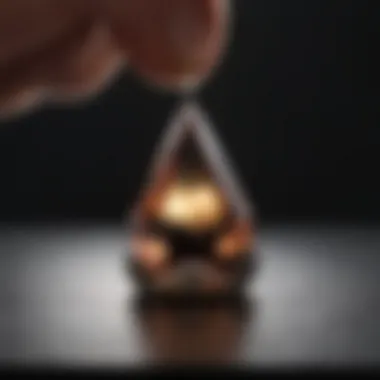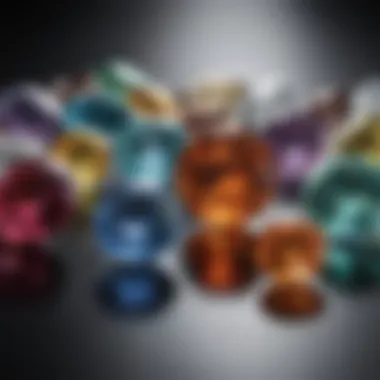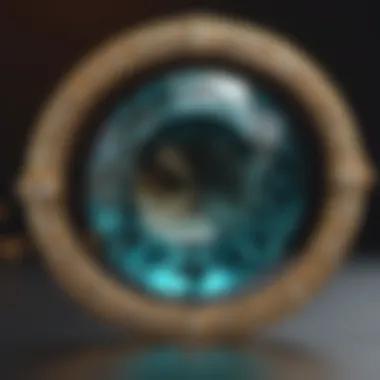Understanding Carat Measurement in Gemstones


Intro
The carat measurement is crucial in the realm of gemstones. Its significance extends beyond mere weight; it is central to valuation and classification in the industry. Carat can determine the desirability of certain stones in the market. Understanding this measurement is vital for anyone involved—be it buyers, sellers, or gemstone enthusiasts.
This article explores several key aspects of carat measurement. It will delve into the historical context, calculation methods, and implications for gemstone dealers and consumers. Additionally, we will discuss how various factors influence market value and the distinction between carat and other metrics. By grasping these nuances, individuals can make informed and educated decisions when navigating their gemstone pursuits.
Gemstone Overview
Description of the gemstone
Gemstones are naturally occurring minerals or organic materials that are appreciated for their beauty and rarity. Common types include diamonds, rubies, sapphires, and emeralds. Each stone possesses unique characteristics, from color and clarity to cut and carat weight. These qualities collectively contribute to their overall aesthetic and market appeal.
Physical properties
Gemstones exhibit diverse physical properties, which are essential in assessing their value. Key physical properties include:
- Hardness: This determines how resistant a gemstone is to scratching. The Mohs scale rates hardness from 1 (talc) to 10 (diamond).
- Density: This describes how much mass is contained in a given volume.
- Refractive Index: This measures how much light is bent when entering the gemstone.
- Birefringence: This shows how a stone splits light into two rays, affecting how it appears under different lighting conditions.
Understanding these properties is vital for evaluating gemstones beyond carat weight alone. Each element plays a role in determining the stone's true value and potential market performance.
Important Note: Carat weight alone does not dictate quality. Other factors like cut, clarity, and color also contribute significantly to a gemstone's overall appeal and worth.
Healing Properties
Metaphysical attributes
Many believe gemstones carry metaphysical properties that can impact one's emotional and physical well-being. For instance, amethyst is thought to promote calm and clarity. Meanwhile, citrine is often associated with prosperity and abundance.
Common uses in holistic practices
Gemstones find use in various holistic practices, including:
- Meditation: Certain stones are placed in spaces to create a calming environment.
- Crystal Healing: Practitioners may use specific stones to help with physical ailments or emotional issues.
- Jewelry: Wearing gemstones is believed to provide protective or healing benefits.
By understanding their metaphysical attributes, enthusiasts can choose gemstones that resonate with their personal beliefs and wellness goals.
Engaging with the topic of carat measurement in gemstones allows individuals to navigate the complexities of the gemstone market with greater ease and insight. It empowers them to make well-informed choices based on more than just numbers.
Intro to Carat Measurement
Carat measurement plays a crucial role in the gemstone industry, serving as a method for assessing both the weight and value of gemstones. This topic is essential to understand for both buyers and enthusiasts as it impacts the overall perception and pricing of stones. It provides clarity on how gemstones are classified and valued. When someone is looking to invest in a gemstone, knowing about carat measurement helps them make well-informed decisions.
Definition of Carat
The carat is a unit of weight used for measuring gemstones and pearls. One carat equates to 200 milligrams. This definition is critical because it sets the foundation for how gemstones are weighed and valued. The term "carat" itself is derived from the carob seeds that were historically used as a balance scale when merchants weighed precious stones. This historical context highlights the longstanding tradition behind gemstone valuation.
Understanding the definition of carat is not merely about numbers; it reflects significant insights into trade practices, historical methodologies, and the importance of precise measurements in modern markets.
History of Carat Measurement
Origins and Historical Use
The origins of carat measurement can be traced back to medieval trading practices, where gemstones were weighed against seeds from the carob tree. This method was simple but effective, allowing traders to establish a relatively standardized form of measurement for valuable stones. The practical use of carat allowed for more straightforward transactions and ensured fairness in trade. This historical technique underscores the necessity of a common unit of measurement in the gemstone market.
This old practice shows that defines a crucial aspect of how weight influenced trade dynamics. As gemstones became more recognized in various regions, these early methods of carat measurement paved the way for modern standards. Without this historical foundation, understanding current practices would be more difficult.
Evolution of the Carat Standard


The evolution of the carat standard reflects significant changes in trade and gemology over the centuries. Initially, many different regions relied on their systems, leading to inconsistencies. Over time, as international trade increased, there was a growing need for a universal standard. The carat was standardized in the late 19th century, which helped to unify the market and ensure fair pricing.
The key characteristic of this evolution is the shift from local practices to a globally accepted standard. This transition was crucial for gem dealers and consumers as it fostered trust and transparency in transactions. The unique feature of this evolution is its adaptation to modern trade needs, where precise measurement is critical. However, while this standardization has many advantages, it can sometimes overshadow variations in quality, which are essential for evaluating true value.
Understanding Carat Weight
Carat weight is one of the most significant metrics in the gemstone industry. It not only indicates the physical weight of a gemstone but also serves as a crucial factor in its valuation. Understanding carat weight enables enthusiasts, collectors, and professionals alike to gauge the worth of gemstones accurately. This section will explore the specifics of carat conversion and clarify common misconceptions surrounding carat weight.
Conversion of Carats to Grams
To understand carat weight, one must first grasp the conversion of carats to grams. A carat is defined as 200 milligrams, or 0.2 grams. This relationship is fundamental for those in the gemstone trade and for consumers who wish to make informed decisions. The simplicity of this conversion allows for straightforward communication between buyers and sellers.
For instance, if a gemstone weighs 1 carat, it is equivalent to 0.2 grams. Knowing this helps purchasers appreciate the actual weight and value of the stones they are considering.
In practice, converting carats to grams can be done using the following formula:
This basic calculation acts as a foundation for many discussions regarding price per carat and overall value, emphasizing the importance of carat measurement in evaluating gemstones.
Common Misconceptions about Carat Weight
Carat weight often leads to confusion, given its implications for value and size. The first misconception is that higher carat weight always means a more valuable gemstone. In reality, while carat weight influences value, other factors such as quality, clarity, and color play a significant role as well. A 2-carat diamond may not be as valuable as a 1-carat diamond of superior quality.
Another misunderstanding is that carats determine the gemstone's physical size. This is not true, as different gemstones have varying densities. For example, a 1-carat sapphire may appear smaller than a 1-carat diamond due to the specific gravities of the two materials. Therefore, size cannot be solely gauged by weight.
"Understanding the complexity of carat weight and its interactions with other quality factors is vital for anyone involved in gemstones."
Lastly, some believe that the term "carat" refers exclusively to diamonds. While the measurement is widely recognized in the diamond industry, it is equally applicable to other gemstones. Knowledge of these misconceptions can greatly enhance the understanding of carat weight and its implications in gemstone valuation.
Carat Measurement in Gemstones
Carat measurement is vital in the world of gemstones. It's not just a simple number; it's a critical factor that influences valuation and desirability. Understanding carat measurement helps both buyers and sellers in navigating the complex market of gemstones.
When it comes to evaluating gemstones, carat weight provides a foundational metric. Larger stones tend to be rarer and more prized. However, carat is only one aspect of a gemstone's overall quality. Thus, understanding how carat weight interacts with other quality factors is essential for making informed decisions.
Measuring Carat in Different Types of Gemstones
Precious Stones
Precious stones, including diamonds, rubies, sapphires, and emeralds, are often synonymous with high value and desirability. The carat measurement plays a key role in determining their market price. A larger carat weight in these stones can significantly increase value due to their rarity.
Key characteristic: Precious stones often possess superior hardness and brilliance compared to other stones. This makes them appealing not only for jewelry but as investment pieces as well.
Unique feature: One downside is that the price per carat skyrockets with size. For instance, a two-carat diamond is often far more expensive than two one-carat diamonds, reflecting the value attributed to larger sizes in high-quality gems.
Semi-Precious Stones
Semi-precious stones, such as amethyst, garnet, and aquamarine, provide a more accessible alternative for buyers. While generally lower in price, these stones still hold value, particularly when considering their carat weight.
Key characteristic: Semi-precious stones are often more abundant than precious stones, resulting in lower prices per carat. This makes them attractive for collections and everyday jewelry.
Unique feature: A major advantage is the variety available. Buyers can select larger stones at more moderate price points without sacrificing quality too much, making semi-precious options notably appealing.
Synthetic vs. Natural Stones
The distinction between synthetic and natural stones is an important aspect of carat measurement. Synthetic stones are manufactured in labs and can offer similar properties to natural gems.
Key characteristic: While synthetic stones may carry identical carat weights to their natural counterparts, they typically cost less. This makes them a popular choice for those who want beauty without the high cost.


Unique feature: However, synthetic stones may lack the historical and emotional value that natural stones possess, particularly in the context of heirloom pieces.
Carat vs. Size
Understanding the difference between carat and size is key in gemstone purchasing. Carat represents weight, while size refers to dimensions—how large a stone appears relative to its weight.
For example, a one-carat diamond may appear smaller than a one-carat amethyst because of their different densities. Therefore, carat weight does not always equate to perceived size. It is crucial for consumers to evaluate gemstones based on both dimensions and weight for a more accurate understanding of their overall appearance.
"In the gemstone industry, understanding both carat weight and size is critical for informed buying decisions."
Impact of Carat Weight on Value
Carat weight plays a significant role in determining the value of gemstones. Understanding the impact of carat weight is essential for gem buyers, sellers, and collectors. The carat is a metric that measures the weight of a gemstone, with one carat equivalent to 200 milligrams. However, the weight of a gemstone does not solely dictate its price. Other factors, such as quality and market trends, also influence value considerably.
Role of Carat in Gemstone Pricing
In the gemstone market, pricing is influenced heavily by carat weight. Larger gemstones, having higher carat weight, are often more rare and desirable. This rarity can exponentially increase their prices. For example, a one-carat diamond may be considerably more affordable than a two-carat diamond, which represents higher value not just for its weight, but also for its scarcity.
However, the pricing dynamics can vary across different types of gemstones. While diamonds see a drastic price jump with carat weight increase, other stones, such as amethyst, may not exhibit the same trend.
Here are some key elements that explain the role of carat weight in pricing:
- Rarity: Larger stones are less common, making them more sought after.
- Consumer Perception: Many consumers equate larger stones with quality, even without assessing other factors.
- Market Demand: High demand for larger gemstones can cause price surges.
Market Trends and Carat Weight
Market trends also shape the perception of carat weight among consumers. For instance, there has been a growing trend towards custom and unique pieces, which can sometimes value smaller carats more than larger ones, depending on the design and craftsmanship involved. Additionally, gemstone investment has increased interest in carat weights, prompting fluctuations in prices.
In recent years, the eco-conscious movement is impacting gemstone sales too. More buyers are looking for sustainably sourced stones, regardless of their carat weight, which can shift market preferences and affect price points.
Trends influencing carat weight's value include:
- Shift to Customization: Unique designs may appreciate smaller carat weights.
- Investment Mindset: People are considering longer-term value rather than immediate resale potential.
- Ethical Sourcing: Eco-friendly options become attractive, diversifying choices for consumers.
"Understanding gemstone pricing involves comprehending how carat weight interacts with market variables."
Overall, while carat weight is a crucial metric in the valuation of gemstones, it must be considered alongside other characteristics and market influences to arrive at an accurate appraisal.
Factors Influencing Carat Value
In the world of gemstones, carat weight is just one of many components that determine a stone's overall value. Therefore, when considering carat measurement, it is vital to acknowledge other influential factors that contribute significantly to the market price and desirability of gemstones. These factors include quality aspects beyond carat weight, such as color, clarity, and cut.
Understanding these quality determinants helps enthusiasts and collectors assess the overall worth of gemstones. For instance, a smaller gem of outstanding quality can often be more coveted than a larger stone that lacks brilliance. Hence, the interplay of carat and these other attributes is essential for a complete understanding of gemstone valuation.
Quality Factors Beyond Carat Weight
Color
Color plays a crucial role in determining a gemstone's appeal and value. It involves both hue and saturation. The key characteristic of color in gemstones is how vibrant and rich the color appears; the more vivid the hue, the more prized the gem typically is. For example, deep blue sapphires or vivid green emeralds are considered more valuable than pale counterparts due to their striking visual qualities.
Additionally, color can affect market demand. Certain colors are often associated with luxury and exclusivity, making them desirable to collectors. However, a unique feature of gemstone color is that personal preference varies significantly among buyers. Thus, what is regarded as attractive or beneficial can greatly depend on individual taste. This variability can introduce both advantages and disadvantages in value assessment, as trends can shift and impact desirability.
Clarity
Clarity refers to the internal and external imperfections within a gemstone. It is an essential factor that can influence both beauty and value. The key characteristic of clarity is the level of visible inclusions or blemishes; fewer imperfections correlate with higher value in most gemstones. This is because clarity affects how light interacts with a stone, and clearer stones often exhibit better brilliance and fire.
One unique feature of clarity is that some buyers may appreciate certain inclusions, viewing them as fingerprints of nature that add character. This perspective can make certain stones more valuable for specific collectors who are inclined toward uniqueness over perfection. However, the disadvantage of inclusions lies in the potential for reduced light performance, which can negatively affect market value.
Cut


The cut of a gemstone refers to how well it has been shaped and faceted. The key characteristic of cut is how it influences the stone's overall light performance and visual impact. A well-cut gemstone maximizes brilliance and reflects light effectively, making it more appealing to buyers than a poorly cut stone of the same carat weight.
Notably, the unique feature of a gemstone's cut is that it significantly contributes to its perceived value. Different shapes appeal to different audiences; for instance, round brilliant cuts are generally favored in the market, but some collectors may prefer unique shapes like pear or cushion cuts for their distinctiveness. The disadvantage here is that while a beautiful cut may enhance value, it does depend on buyer preferences and market trends, which can be fluid.
Overall, when evaluating gemstones, it is necessary to assess these quality factors beyond just carat weight. A comprehensive understanding assists in making informed decisions when pursuing gemstones. By focusing on color, clarity, and cut alongside carat weight, one can appreciate the complex nature of gemstone valuation.
Notable Gemstone Carat Examples
The significance of notable gemstone carat examples transcends mere weight; they illustrate the intersection of rarity, beauty, and value within the gemstone realm. These prominent stones not only capture public imagination but also provide a practical lens through which to evaluate the potency of carat metrics. Understanding these examples can offer clarity to enthusiasts and professionals seeking to appreciate or invest in gemstones.
Famous Large Gemstones
Famous large gemstones serve as prime illustrations of how carat weight can impact both aesthetic appeal and market value. One such stone is the Cullinan Diamond, which at a remarkable 3,106 carats is the largest gem-quality diamond ever discovered. Its vast size enhances its allure but also calls attention to the complexity involved in its valuation. Large gemstones like the Cullinan are rare. This rarity can significantly inflate their market price, leading to values that reach into the millions.
Another notable example is the Hope Diamond, weighing in at 45.52 carats. This diamond has a storied history and is part of the Smithsonian Institution's collection. Its rich blue coloration, combined with its impressive size, makes it a focal point for gemstone collectors. The Big Pink, a 23.15-carat pink diamond, also stands out. Its unique color and size propel it into a class of its own, often perking the interest of connoisseurs.
These famous gemstones exemplify how larger carat weights can yield not only significant monetary value but also cultural and historical importance, elevating them beyond mere jewelry.
Implications of Carat in Historical Stones
Carat measurement carries historical implications that can reveal much about the societal context in which particular stones were valued. Historical stones often speak to the technological innovations of their time. For instance, advancements in cutting techniques have allowed larger stones to maintain their integrity without sacrificing clarity and brilliance. The Koh-i-Noor Diamond, part of the British crown jewels and weighing in at 105.6 carats, showcases how historical context and craftsmanship intertwine.
Moreover, as gemstones pass through various hands and cultures, their ownership contributes to their valuation. The Sancy Diamond has bounced between royal families and countries, each time its carat weight reflecting changing market perceptions and economic conditions. It weighs 55.23 carats and has survived centuries, embodying both resilience and adaptability.
Through the lens of notable gemstones, we see how carat weight serves both as a quantitative measure and a narrative device, illustrating evolving attitudes towards beauty, wealth, and ownership throughout history.
"The true value of a gemstone often lies not only in its carat weight but in its story and place in history."
The Future of Carat Measurement
As the gemstone industry evolves, the future of carat measurement holds significant implications for both gem dealers and consumers. Technology and changing market demands will likely reshape how carats are measured and interpreted. Understanding these potential changes can empower buyers and sellers to make informed decisions, enhancing their engagement with the market.
Additionally, precision in measurement will become increasingly important. Advances in technology could allow for more accurate measurements, reducing discrepancies that can arise from traditional weighing methods. As tools and methods improve, trust between parties in a transaction may strengthen.
Innovations in Gemstone Measurement
Innovation in gemstone measurement technologies is set to redefine industry standards. New devices are emerging that can measure not only the weight of gemstones but also their dimensions and volume with high precision. Tools like laser scanners and digital calipers play a crucial role in this transformation.
Moreover, innovations are not just limited to technology. Developments in machine learning and artificial intelligence may lead to algorithms that can efficiently evaluate the quality of gemstones based on their carat weight alongside other essential factors like clarity and color. Such advancements could standardize evaluations and enhance market fairness.
"In the future, gemstone evaluation will rely heavily on both traditional wisdom and emerging technologies."
These innovations can help consumers understand that carat weight is only part of the equation in pricing and quality evaluation. Buyers will benefit from tools that provide clearer insights into the gemstone's overall characteristics, ensuring they make knowledgeable choices.
Consumer Education and Awareness
As the landscape of gemstone evaluation progresses, consumer education is more important than ever. Knowledge about carat measurement and its implications enables consumers to approach the market confidently. Awareness initiatives should focus on what carat weight means in context, addressing common misconceptions that can mislead buyers.
Workshops and online platforms can serve as valuable resources for enhancing consumer understanding. Many consumers may not realize that a higher carat weight does not automatically equate to superior quality. Tailored information should emphasize that clarity, color, and cut are equally, if not more, significant when determining a gemstone's value.
Ultimately, an informed consumer base fosters a mature marketplace. As buyers become better educated about gemstone metrics, they can engage in more meaningful transactions. This evolution reflects the ongoing commitment across the industry to prioritize consumer knowledge alongside traditional methods of measurement.
Culmination
In this article, we have delved into the intricacies of carat measurement in gemstones, highlighting its critical role in the gemstone industry. Understanding carats goes beyond simply numbers; it intertwines with the valuation, selection, and appreciation of gemstones. By grasping the historical context, the conversion metrics, and the various factors that influence market value, readers can enhance their gemstone knowledge significantly.
Summary of Key Points
- Definition of Carat: A carat symbolizes weight in gemstones, equating to 200 milligrams. It serves as a standard measurement for both precious and semi-precious stones.
- Historical Development: The carat system has evolved from ancient trade practices, providing a consistent unit of weight for gem transactions.
- Value Impact: The weight of a gemstone directly correlates with its market price. Larger carats typically command higher prices, but quality factors like color, clarity, and cut play significant roles as well.
- Market Awareness: Understanding trends in carat weight helps consumers make educated purchasing decisions, influencing their investments.
Final Thoughts on Carat Importance
The carat measurement is not just a simple metric; it is an essential component of gemstone evaluation and commerce. It allows for clarity in the marketplace, giving buyers and sellers a common language in discussions of value. Moreover, the conclusion drawn from this study encourages collectors, jewelers, and enthusiasts to develop a discerning view of how carats influence the perception and value of gemstones.
Having a well-rounded understanding of carat weight enables informed decisions, which are vital in an industry full of nuances. It empowers consumers to appreciate their gems fully, ensuring they recognize not only the weight of a stone but also its overall quality and value.







